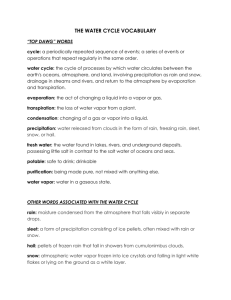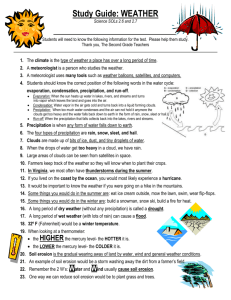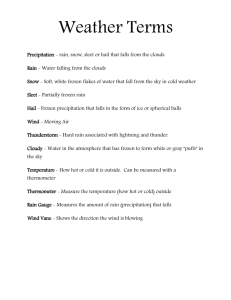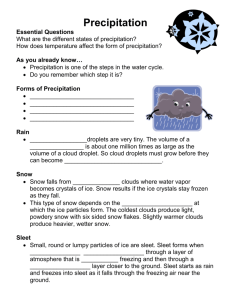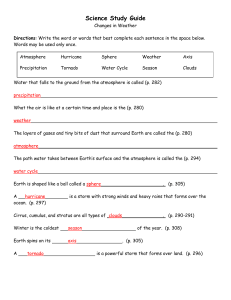climate - Dijaski.net
advertisement
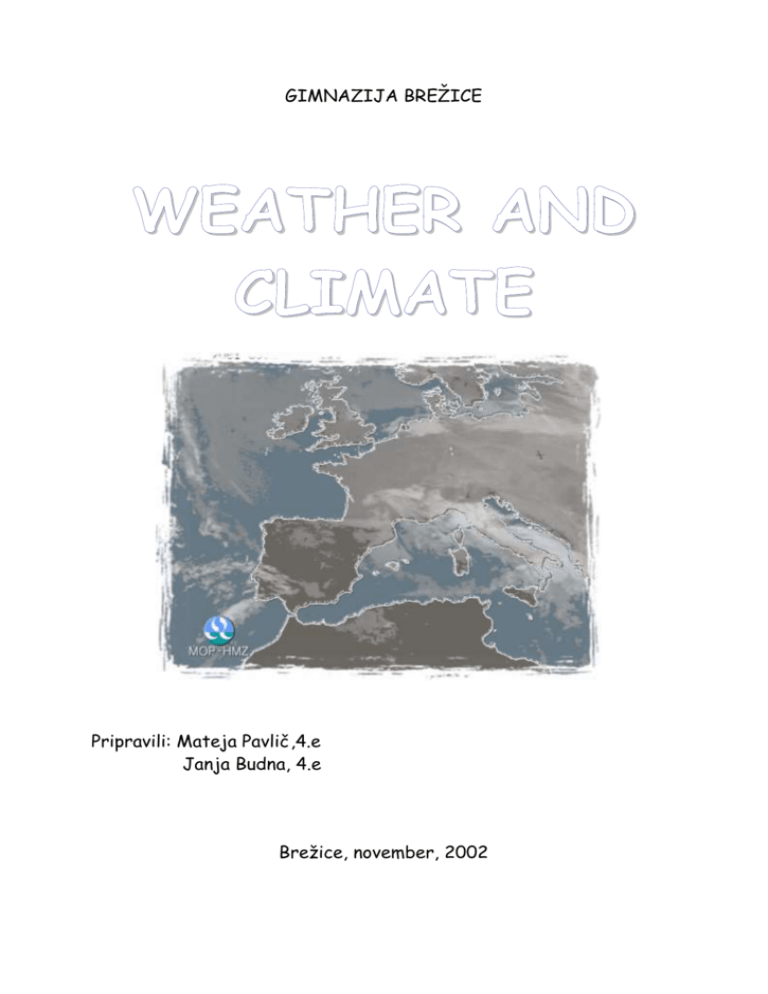
GIMNAZIJA BREŽICE WEATHER AND CLIMATE Pripravili: Mateja Pavlič,4.e Janja Budna, 4.e Brežice, november, 2002 CLIMATE Climate is the sum of all weather events in an area during a long period of time. Climatologists describe the climate in terms of an area’s average monthly and yearly temperatures and amounts of precipitation. Precipitation consists of rain, snow, hail and other forms of moisture that fall to earth. Every place on the earth, no matter how small, has its own climate. Places that lie far apart may have a similar climate. There may be important differences between the climate of a hill and a nearby valley, or of a city and the surrounding countryside. Climatologists have developed various systems of climatic classification. However, we know 12 major kinds of climate: Tropical Wet – always hot and always wet; heavy precipitation well distributed throughout the year (South America, Indonesia) Tropical Wet and Dry – always hot, with alternate wet and dry seasons; heavy precipitation in the wet season (South America, Africa) Highlands – these areas are affected by altitude and are generally cooler and wetter than the adjacent climates (Asia, North America. South America) Desert – hot to cold, with great changes in daily temperature except in coastal areas; little precipitation (Australia, North and South America) Steppe – hot to cold, with great changes in daily temperature except in coastal areas; little precipitation (South America, Australia, Asia, Africa) Subtropical Dry Summer – hot, dry summers and mild, rainy winters; moderate precipitation in winter Subtropical Moist – warm to hot summers and cool winters; moderate precipitation in all seasons (North and South America, Australia, Asia) Oceanic Moist – moderately warm summer and mild, cool winter; moderate precipitation in all seasons (New Zeeland, Europe, South and North America) Continental Moist – warm to cool summer and cold winter; moderate precipitation in all seasons (North America, Europe, Asia) Sub arctic – short, cool summer and long, cold winter; light to moderate precipitation, mostly in summer (North America, Asia) Polar – always cold, with a brief chilly summer; little precipitation in all seasons (North America, Asia) Icecap – always cold, average monthly temperature never above freezing; precipitation always in the form of snow (Antarctica) Reasons, why the climate of one place is different from another, are: differences in latitude - Places at different distances from the equator receive different amounts of energy from the sun. This energy difference occurs because the position of the sun in the sky varies with latitude. differences in availability of moisture - The air absorbs the greatest amount of moisture from warm parts of the ocean near the equator. Winds carry this moisture to the land where it may fall to the ground as precipitation. differences in land and water temperatures – water heats and cools more slowly than land does, so a continent may be warmer in summer than the coast, in winter a continent may be colder than the coast, which is warmed by the ocean air. differences in the land surface WEATHER Weather is not the same as climate. Weather is the condition of the air during a brief period. The weather may be hot or cold, cloudy or clear, windy or calm. And it may bring frost, rain, snow, sleet or hail. All weather develops in the atmosphere. It consists chiefly of the gases nitrogen and oxygen. It also has small amounts of other gases. The atmosphere extends far above the earth’s surface. Above a height of about 160 kilometres, there is almost no air. This region is called space. Nearly all weather occurs in the lowest layer of the atmosphere. This layer, called the troposphere, begins at the surface of the earth and extends from 10 to 16 kilometres away from the surface. Weather conditions in the troposphere and on the earth depend on 4 elements: temperature air pressure wind moisture Weather occurrences Rain – it falls when the drops of water that form clouds combine and become so heavy that the air can no longer hold them up Snow – if the temperature of the clouds is below freezing, ice crystals form. They can turn to snow if the temperature of the air near the ground is about 2,8° C Sleet – if the temperature is between 2,8° and 3,9° C the ice crystals change to sleet Hail – it forms when strong air currents carry ice crystal up and down between the top and bottom layers of a thundercloud. The crystals become larger and larger until they fall to the earth as hailstones Fog – low clouds; it can form at night or during the day Frost – frozen dew; if the dew point is below freezing Storms – are periods of violent weather Types of storms include: o thunderstorms o winter storms o tornadoes o hurricanes o sandstorms Weather forecasting People have tried to predict the weather for thousand of years. Today, scientists use complex instruments, such as radar, satellites, and computers, to forecast the weather. The forecasts are broadcast on radio and television stations and published in newspapers. Weather forecasting enables us to make plans based on probable changes in the weather. For most of us, it is usually just a convenience to know in advance what the weather may be. Forecast help us decide what clothes to wear and whether to plan out-door activities. But the weather forecast also has much greater importance. Reports on the direction and speed of the wind enable aeroplane pilots to determine how much fuel they need for a flight. Before builders pour concrete, they need to know if it will rain and ruin the concrete before it hardens. If farmers receive warning of a frost, they can take steps to protect their crops. Predictions of tornadoes, hurricanes and floods can save many lives and reduce the damage to property. The facilities for observing the weather include: observation stations – measure conditions on land weather balloons – send data to ground stations or satellites satellites (polar-orbiting and geostationary)– relay weather information, take pictures of the earth planes and ships – take weather measurements buoys – transmit data on conditions at sea to satellites The scientists who forecast the weather are called meteorologists. They collect data on the condition of the atmosphere throughout the world. They use this information to prepare maps that show the temperature, air pressure, wind and moisture in various areas. The meteorologists then analyse the maps and prepare their forecasts. There are two main kinds of forecasts: short-range forecast – they predict the weather over the next 18 to 36 hours, these forecasts are updated several times a day as meteorologists receive new weather data extended forecast – predict weather over the next 5, 10 or 30 days Ship Weather balloon Observation station Weather forecast for Slovenia Here is the weather forecast for Slovenia for the next twenty-four hours: North East: There will be mainly dry and sunny, but quite chilly with temperature around 5° in the morning and 12°C in the afternoon. There will be quite windy, so wrap up warm. West, South West and North West: You can expect some rain. The temperature will be around 6°C in the morning and 11°C in the afternoon. It will be cloudy all day. East and South East: There will be cloudy, with some sun, and windy. VIRI IN LITERATURA: The World Book Encyclopedia Internet: www.krsko.com VOCABULARY – the degree of heat in the atmosphere – the force of the atmosphere pushing on the earth WIND – the movement of air from a high-pressure area to a low-pressure area; they are named after the direction from which they blow MOISTURE – enters the atmosphere in the form of water vapour VAPOUR – the gas - like form into which a substance can be changed by heating AIR MASS – an enormous body of air that forms over a region in which the temperature is fairly constant FRONT – a zone that develops when the edge of a cold air mass and the edge of a warn air mass meet HIGH-PRESSURE AREA – an area in which the force of the atmosphere on the earth is relatively high; clear skies LOW-PRESSURE AREA – an area in which the force of the atmosphere on the earth is relatively low; cloudy skies HUMIDITY – the measure of the amount of water vapour in the air PRECIPITATION – moisture that falls from clouds in the form of rain, snow, sleet of hail SATURATED AIR – air that holds as much moisture as it can; the cooler air becomes, the less moisture it can hold DEW POINT – the temperature at which the air becomes saturated DEW – drops of water, which settle on grass, leaves, windows and other surfaces, when the temperature of air falls below the dew point, usually on calm, clear nights SLEET – rain mixed with snow or hail HAIL – small balls of ice falling from the clouds BUOY – a floating anchored mark, acting as a guide, warning or mooring point for boats WEATHER BALLOONS – balloons filled with helium or hydrogen and carry an instrument, called a radiosonde, which take measurements of the atmosphere and send the information to stations on the ground SATELLITE – a man-made object fired into space to travel round (the Earth), they carry television cameras that take pictures of the earth SAND-STORMS – a storm of wind, carrying with it clouds of sand TORNADOES – consists of winds that swirl in the shape of a tunnel at speeds of up to 320 kilometres per hour HURRICANE – large, whirling storms that form near the equator over the oceans CONCRETE – a mixture of cement with sand, used in building TEMPERATURE AIR PRESSURE
